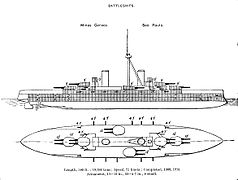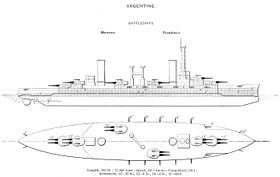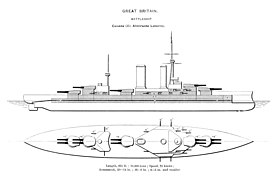Almirante Latorre
|
|
|
|---|---|
 Almirante Latorre , 1921 |
|
| Overview | |
| Type | Battleship |
| Shipyard |
Armstrong, Whitworth & Co. , Elswick, BauNr. 845 |
| Keel laying | May 1, 1912 |
| Launch | November 27, 1913 |
| 1. Period of service |
|
| Commissioning | September 30, 1915 as HMS Canada |
| Whereabouts | Returned to Chile in April 1920 |
| 2. Period of service |

|
| Commissioning | February 20, 1921 |
| Decommissioning | February 27, 1958 |
| Whereabouts | 1958 sold to Mitsubishi Heavy Industries in Japan and scrapped |
| Technical specifications | |
| displacement |
Standard : 28,000 t |
| length |
L pp : 190.5 m |
| width |
28 m |
| Draft |
8.5 m |
| crew |
1167 men |
| drive |
|
| speed |
22.7 kn |
| Range |
4400 nm at 10 kn |
| Armament |
from 1935 additionally:
for that last:
|
| Armor |
|
| Bunker quantity |
3,300 t coal and 520 t heating oil |
The Almirante Latorre was a Chilean battleship ( Buque capital , Spanish for capital ship , which was commissioned from Armstrong in Elswick , Great Britain , on November 27, 1911. After the outbreak of World War I , the ship was bought by Great Britain and served as Canada, and was bought back by Chile in 1920. It was in service until 1958 , when it was broken up in Japan .
Several Chilean frigates later bore the name Almirante Latorre .
History of creation
The construction contract was formally awarded in the context of the 100th anniversary of Chilean independence; in fact, it was due to the Argentine-Brazilian arms race. When Argentina commissioned the Rivadavia and the Moreno in the United States , the Chilean government was of the opinion that Chile also needed two modern battleships to balance forces. Originally the ships should be named after the two largest cities in Chile, Santiago and Valparaíso , then Libertad (freedom) was considered. After the death of Admiral Juan José Latorre (1846–1912), it was decided in July 1912 to name the ship after him. Latorre was considered one of the heroes of the war against Peru in 1879 ( Saltpeter War ) and contributed significantly to the conquest of the Peruvian ironclad Huáscar , now a museum ship of the Chilean Navy. From 1886 to 1887 he was Commander in Chief of the Chilean Navy and from 1898 to 1899 Foreign Minister of Chile.
The design of the two ships, which were to be named Chilean naval heroes Almirante Latorre and Almirante Cochrane , was based on the British Iron Duke class . In addition to the two battleships, Chile ordered six large destroyers (flotilla leaders) of the Almirante Lynch type and two submarines in Great Britain .
The contract to build two battleships was signed with Armstrong Whitworth on July 25, 1911. After the construction plans had been submitted, the Almirante Latorre was ordered on November 2nd and the official laying of the keel of the largest ship to be built at Armstrong in Elswick took place on November 27, 1911. The Almirante Latorre was christened and launched on November 27, 1913 . After the outbreak of World War I, the Almirante Latorre , which was already in equipment , was purchased by Great Britain on September 9, 1914. Unlike the Turkish battleships Reshadieh and Sultan Osman I , which were in the process of being completed and were confiscated by military units, Chile was treated as a “friendly” neutral state. The Almirante Latorre , renamed Canada , entered service on October 15, 1915.
The sister ship Almirante Cochrane was bought by Great Britain in 1917, still lying on the Helgen, and put into service in 1924 as the aircraft carrier Eagle .
Service as Canada
During her service in the Royal Navy, HMS Canada was part of the 4th Battle Squadron of the Grand Fleet and took part in the Battle of the Skagerrak with Royal Oak , Superb , Benbow , Bellerophon , Temeraire and Vanguard . During the battle she fired 42 shells of her heavy artillery in seven volleys, but was not hit herself. The first two salvos were fired at about 6:40 p.m. on the immobilized Wiesbaden , the other five followed when the fleets met at about 7:20 p.m. Their 152 mm guns also fired 109 rounds at German torpedo boats from 7:11 p.m.
On June 12, 1916, the Canada was transferred to the 1st Battle Squadron as part of a larger ship swap. In 1918 she received launch platforms for aircraft on towers B and Y.
In March 1919 the Canada decommissioned and was assigned to the reserve.
Service in the Chilean fleet
The British tried to sell surplus ships at the end of the war. The Chileans, however, were not interested in older ships, but insisted on their relatively modern pre-war orders. In the end, in April 1920, Chile acquired the Canada , the three remaining destroyers of the Faulknor class ordered before the war, and a tug . The five ships together cost less than a third of the price Chile wanted to pay for the Almirante Latorre in 1914 . The Canada got its old name again and was returned to Chile on November 27, 1920. On the same day, she left Plymouth with the two destroyers Almirante Riveros (ex Faulknor , originally Almirante Simpson ) and Almirante Uribe (ex Botha , originally Almirante Goni ) under the command of Admiral Luis Gomez Carreño .
On February 20, 1921, the association arrived in Chile, where it was welcomed by President Arturo Alessandri . Almirante Latorre became the new flagship of the Chilean Navy in place of the battleship O'Higgins . With the commissioning of the Almirante Latorre , Chile was able to establish a balance of forces with the Argentine Navy; it was clearly superior to the Peruvian. At the time, the battleship was the largest warship a Latin American Navy had ever owned.
In 1929 the Almirante Latorre was sent to the Devonport Dockyard for modernization. She left Chile on May 15 and ran through the Panama Canal to Port of Spain , where she picked up fuel on May 28. She continued across the Azores and arrived in Plymouth on June 24th . The bridge was modernized and the fire control system renewed. Another mast was installed between the third and fourth tower. The turbine system was changed and renewed and completely converted to oil firing. In addition, the ship received torpedo bulges similar to the British Queen Elizabeth class and modern anti-aircraft armament. Almost two years after the start of modernization, the Almirante Latorre began her return journey to Valparaíso on March 5, 1931, where she arrived on April 12. On the return voyage, she transported two tugs on deck, which were to be used in Punta Arenas and Valparaíso.
On September 1, 1931, the sailors mutinied aboard the Almirante Latorre , the battleship O'Higgins , seven destroyers and a few submarines. The mutiny was supposed to be put down by the use of aircraft of the Chilean Air Force ( Fuerza Aérea de Chile ). However, the air attack was repulsed.
In 1933, the Almirante Latorre in Talcahuano was deactivated to reduce government spending. Only a maintenance crew remained on board. In 1937 it was overhauled in Talcahuano and used for safety trips from 1939 onwards. At the beginning of the Second World War in the Pacific , the United States wanted to buy the ship for the United States Navy , but the Chilean government refused.
After an accident in the engine room with three dead in 1951, the Almirante Latorre , moored at the Talcahuano pier, served as a fuel oil storage facility. In 1958 it was decommissioned and sold to Mitsubishi Heavy Industries for scrapping in Japan . Some of the remaining equipment was reused in the battleship Mikasa, which has become a museum ship .
South American battleships
after Brassey's Naval Annual (1915)
The Brazilian Minas Geraes class was designed and completed before the other battleships for South American states and was smaller and less armed than the later ships. Brazil later planned two more battleships to remedy this deficiency: the Rio de Janeiro and the Riachuelo . Since the costs could not be raised, the Brazilian government sold the unfinished Rio de Janeiro to the Ottoman Empire , while for the Riachuelo not even the keel had been stretched until the beginning of the First World War . Rio de Janeiro , which was sold to Turkey, was confiscated by the British when the war broke out and renamed Agincourt . It was scrapped after the war.
The Argentine Rivadavia- class was the second class of South American battleships to be ordered and built. Unlike the other ships, the class was not ordered from British shipyards, but from the USA. The ships of the class had heavy artillery of the same caliber (12 inches) as the Minas Geraes class. However, the Argentine ships were considerably larger and better armored than their potential Brazilian opponents
Almirante Latorre was the last battleship completed for a South American Navy. The ship built for Chile was larger and better armored than the battleships of Brazil and Argentina, but only came to Chile in 1920 because of the World War. It had a very powerful main armament with five 14-inch twin turrets, all of which stood on the center line and could be used on both sides. The second Chilean ship was completed as the British aircraft carrier Eagle .
Other ships named Almirante Latorre
The Chilean Navy had or still has four other ships with this name:
- from 1971 to 1984 the cruiser Almirante Latorre , the former Swedish Göta Lejon , a cruiser of the TreKronor class , which was canceled in 1986
- from 1986 to 1998 the destroyer Almirante Latorre (DLH-14), the former British glamor organ of the county class ; it sank in 2005 on the way to demolition
- from 2005 to 2020 the frigate Almirante Latorre (FFG-14), the former Dutch Mr. Ms. Jacob van Heemskerk (F812), lead ship of the Jacob van Heemskerck class
- since 2020 the frigate Almirante Latorre (FFG-14), the formerly Australian HMAS Melbourne (FFG 05) of the Adelaide class
literature
- RA Burt: British Battleships of World War One. Naval Institute Press, Annapolis 1986, ISBN 0-87021-863-8 .
- Alexander Bredt (Hrsg.): Weyer's pocket book of the war fleets. XXXVI. Born 1943/44, Munich / Berlin 1944, 3rd new edition. Bonn 1996, p. 94 u. 372.
- Adrian J. English: The Armed Forces of Latin America. Their Histories, Development, Present Strength and Military Potential. 2nd ed., London 1985, p. 38f.
- Seward W. Livermore: Battleship Diplomacy in South America 1905-1925. The Journal of Modern History 16: no. 1, 1944, pp. 31-44, JSTOR 1870986.
- Robert L. Scheina: Argentina "and" Chile "in Conway's All the World's Fighting Ships 1906–1921, edited by Robert Gardiner, Randal Gray, Naval Institute Press, Annapolis 1984, ISBN 0-87021-907-3 .
- Robert L. Scheina: Latin America: A Naval History 1810–1987. Naval Institute Press, Annapolis 1987, ISBN 0-87021-295-8 .
- Bruno Weyer: Paperback of the war fleets. XV. Born 1914, Munich 1914, Reprint Koblenz 1983, pp. 26,170.
- MJ Whitley: Battleships of World War Two: An International Encyclopedia. Naval Institute Press, Annapolis 1998, ISBN 1-55750-184-X .
Web links
- Various images of the Canada during service in the Royal Navy.
- Various images of the Almirante Latorre during her service in the Chilean Navy. ( Memento from September 5, 2007 in the Internet Archive )
- The Almirante Latorre on the side of the Chilean Navy ( Memento from September 21, 2013 in the Internet Archive )
Footnotes
- ↑ http://www.navweaps.com/Weapons/WNBR_14-45_mk1.htm
- ↑ http://www.navweaps.com/Weapons/WNBR_6-50_mk17.htm
- ↑ http://www.navweaps.com/Weapons/WNBR_3-45_mk1.htm
- ↑ QF is the abbreviation for "quick fire" and means that the grenade and cartridge were connected to one another, which shortened the loading time. HA stands for "high angle" and means that such a gun is mounted on a high base mount and can therefore also be aimed at a steep angle (for air defense ).
- ↑ http://www.navweaps.com/Weapons/WNBR_4-45_mk5.htm
- ↑ http://www.navweaps.com/Weapons/WNBR_3pounder_V_mk1.htm
- ↑ http://www.navweaps.com/Weapons/WNBR_2pounder_m2.htm
- ↑ Classifying term as defined in "PART 4. Definitions" of the Washington Fleet Agreement of 1922 )
- ↑ Livermore, p. 42.
- ↑ Scheina: Naval History. P. 322; Chile. P. 408.
- ↑ a b c d e f g Burt, p. 240.
- ↑ Campbell, pp. 157, 206f.
- ↑ Campbell, p. 210.
- ↑ Livermore, p. 48.
- ↑ Chile's War Fleet Sails, NYT November 28, 1920
- ↑ a b c Whitley, p. 33.
- ^ Chile Lays Up All Battleships in Drastic Economy Measure. New York Times January 19, 1933.
- ↑ a b Scheina: Naval History. P. 82.
- ^ Vanterpool: The Riachuelo. P. 140.
- ↑ Scheina: Argentina. P. 401.




